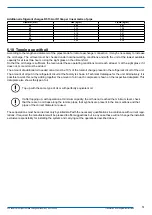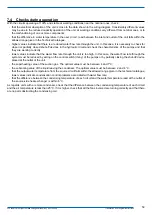
47
We reserve the right to make changes without any prior notice.
Translation from original instructions
6.8 Refrigeration connections
For the "LC" (condenserless) versions, the refrigerant connections must be made between the unit and the remote heat
exchanger.
The "LC" version units are "dry run" tested, and the refrigerant circuit is charged at the factory with a mixture of nitrogen and
helium at a pressure of about 10 bar.
Check that the unit is pressurised as this will confirm that the refrigerant circuit has not been damaged in
transit.
The following operations require pressurised pipes and brazed connections to be made, and these must be
carried out by skilled staff with the necessary qualifications in accordance with current regulations.
The sizing and construction of the refrigerant lines affect the reliability and performance of the product.
The following sections list some suggestions for making the refrigerant lines, but the installer is in any case
responsible for their correctness.
If the safety valves are dispatched with the unit, the customer is required to install them.
In the "LC" version, the safety valves are always supplied with the unit.
In the LC version, the liquid receiver is an accessory; if required, it is always dispatched with the unit.
In the case of "LC" units with just one refrigerant circuit combined with remote dual circuit condensers, it is
necessary to make a suitable manifold to join the two gas connections and the two liquid connections.
6.8.1 Making the piping with remote heat exchanger (LC versions)
In order to lay the pipes, use copper pipes, of a size suitable for the cooling capacity and the distance to be covered and of
an adequate thickness for the maximum design pressure and the type of refrigerant used.
The route of the pipes must be as short and straight as possible, making sure the following basic rules are complied with:
- use the fewest number of bends possible, preferably as wide as possible;
-
make a slight slope in the delivery line (1%) in the horizontal sections so that the oil is conveyed more easily;
-
fit suitable syphons every 4 metres, in the vertical riser sections of the delivery pipe;
-
support the horizontal and vertical lines with suitable vibration dampers;
- solder the joints, avoiding butt welds by using sleeves or enlarging the tubes;
-
adequately protect the various components such as valves or taps fitted nearby, e.g. by wrapping them with wet rags,
during braze-welding;
- once the junctions have been completed, blow-clean the tubes to remove any dirt;
- press the plant to search for any leaks.
The maximum height difference between the unit and the remote exchanger is 15 equivalent metres for any type of instal
-
lation.
The recommended diameters for equivalent lengths up to 30 m are given below.






























